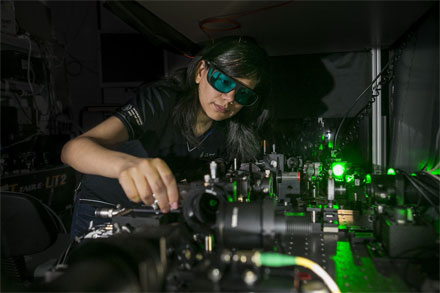A novel nanocrystal, 500 times smaller than a human hair, is capable of changing the intensity, shape and color of light. Developed by researchers at The Australian National University (ANU), the nanocrystal was built on glass so that light could pass through it. It could be used to convert light to the visible spectrum, enabling objects to be seen in very dark environments.
“The nanocrystals are so small they could be fitted as an ultrathin film to normal eye glasses to enable night vision,” said professor Dragomir Neshev.

ANU Ph.D. student Maria del Rocio Camacho-Morales. Courtesy of Stuart Hay, ANU.
The researchers embedded AlGaAs nanostructures in optically transparent low-index material, which allowed for simultaneous forward and backward nonlinear emission. They demonstrated that the nanodisk AlGaAs antennas could emit second harmonic in preferential direction with a backward-to-forward ratio of up to five, and could generate complex vector polarization beams, including beams with radial polarization.
In order to measure the tiny amount of light coming through the nanostructures, the researchers had to fabricate the devices on a glass substrate, determine a way to measure the conversion of the colors from invisible to visible and perform extensive numerical simulations to understand the physics behind the operation of the device.
“…Growing a nano semiconductor on a transparent material is very difficult,” said researcher Maria del Rocio Camacho-Morales.
In addition to its potential as a component in lightweight night-vision glasses, the device could be used to create security holograms in bank notes and in imaging applications.
“These semiconductor nanocrystals can transfer the highest intensity of light and engineer complex light beams that could be used with a laser to project a holographic image in modern displays,” said researcher Mohsen Rahmani.
The research was published in NANO Letters (doi: 10.1021/acs.nanolett.6b03525).
Scientists at The Australian National University have designed a nanocrystal around 500 times smaller than a human hair that turns darkness into visible light and can be used to create lightweight night-vision glasses. Courtesy of ANU.